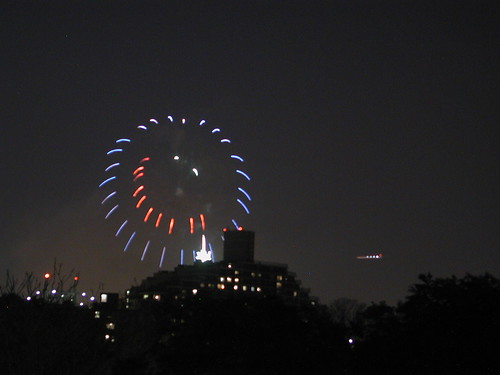I saw a part of a program on the National Geographic Channel today that talked about how fireworks are made. I want to pass along what I learned, and hopefully expand on it.

Four gold fireworks. You can't tell, but these were enormous. It's tough to take a good picture of fireworks. At the very least, you have to get the timing just right.
(Photo by the Apple Lady)
- A firework is made primarily of two parts: a sleeve or tube, and a shell.
- The shell is the part that contains the explosive material that makes all the pretty colors
- The sleeve or the tube holds the shell and provides the initial propulsion to get the shell up into the air as far as it needs to go.

A cluster of fireworks, cut away to show the shells within the tubes
(Diagram from Pyrouniverse)
- Both of these parts are activated by a fuse.
- The fuse that's lit at the top, like the wick at the top of a candle, descends down the inside of the tube to the bottom.
- There, it ignites pellets of various chemicals, generally referred to as black powder. The resulting explosion propels the sleeve with the shell inside it into the air.

Interior of an aerial shell, showing the initial fuse and the secondary charge that ignites the display of sparks
(Diagram from Pyrouniverse)
- As the shell rockets upwards, the second wick, or sometimes a blast charge, is ignited by the sparks from the first explosion. Ideally, the second wick will ignite when the shell has traveled as far into the sky as it needs to.
- When the shell ignites, the chemicals packed inside explode, creating the colorful display.
- Which chemicals that get packed into the shell will determine what sparks the firework makes when the shell explodes.
- Blue -- copper
- Green -- barium salts
- Red -- strontium
- Yellow -- sodium
- Gold -- aluminum
- White (the really flashy ones) -- magnesium
- The arrangement of the particles will also affect what the explosion looks like (Geology.com has a very helpful diagram).
- Larger particles will produce larger sparks; smaller particles will produce finer sparks.
- If the particles are arranged in a circle around the wick, they will create a circular pattern in the sky.
- The particles can also be layered within the shell so that one color explodes first, then a second, then a third, and so on.
- A relatively recent development in firework manufacturing is the use of microchips embedded in the shell that direct the sparks into a particular shape. Fireworks that produce smiley-faces in the sky are so directed by microchips.

Smiley-face firework, courtesy of a little bitty microchip that got burned up when this exploded
(Photo by Eric in NY City)
- Most fireworks displays of any size are coordinated by computer.
- The tubes of fireworks are arranged in box-like clusters.
- Each firework is then connected to a control board with lots of numbered knobs on it. Each number corresponds to a single firework.
- Engineers plan the timing of when each firework is to be ignited. Sometimes the timing is also coordinated with a series of songs.
- It's an extraordinarily painstaking process which is years in the making, but which is over in about twenty to forty minutes.

San Diego's fireworks, here using red, white, and blue colors
(Photo from Search.com)
- For information about what's inside the fireworks available in your local store, check out this page by Pyrouniverse.
Here are more of my paltry attempts at taking pictures of fireworks. These are the best of the bunch and they're not great. It's hard to convey just how huge these things were.




(Photos by the Apple Lady)
Sources
National Geographic Kids, How Fireworks are Made
BBC News Round, How Do Fireworks Work?, October 21, 2005
Holly Hartman, Factmonster, Facts on Fireworks, 2006
Totse.com, Bad Ideas, Background and Basic Chemistry of Fireworks
wow i never knew that haha
ReplyDelete